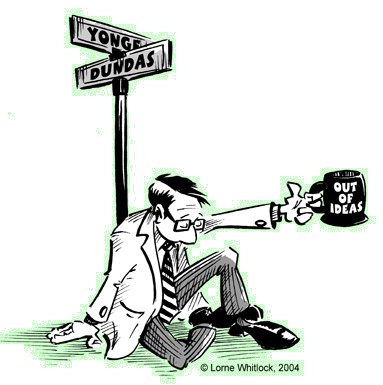Published in the September 2004
issue of the Canadian
Nuclear Society Bulletin, Vol.25, No.3. Artwork
by Lorne Whitlock.
Thoughts on a Street Corner by Jeremy Whitlock On Toronto's Yonge Street everybody is talking to themselves. The Destitute and Disturbed carry on conversations, often angrily, with invisible persons all around. Scuttling past is the cell-phone crowd, likewise carrying on conversations, often angrily, with invisible persons. Nobody takes notice, nobody cares. There is talking everywhere, but no conversation. The celebrated street is said to be the longest in the world (presumably ignoring Main St. Cobden and other towns sitting astride the TransCanada Highway), but draws most attention within a few blocks of its start. Around Yonge and Dundas the diversity of the surrounding urban watershed is concentrated and amplified. Towering homages to mass media block out the sun and bleat messages that few appear to notice. The crowds surge into the Eaton Centre, clutching currency as plastic as the geese that fly within. Everywhere there is noise: subwoofers and car horns, jackhammers and talking billboards, a whining rock radio station and people talking everywhere, to themselves. It is said that Leo Szilard stepped off a curb at another intersection, a world away, on the morning of September 12, 1933, and conceived the neutron chain reaction. It was a simpler world back then: simple enough to be lead down the garden path towards a world war for the second time in as many decades, but also clearly a world conducive to great discovery. At that moment in London the British Association for the Advancement of Science was meeting amidst hurricane-force winds of change in the world of nuclear physics: In 1931 Lawrence's cyclotron caused a revolution (sorry), followed the next year by Chadwick and Anderson's discoveries of the neutron and positron, respectively. In the wings was the Seventh Solvay Conference in Brussels (October 1933), for the first time dedicated to nuclear physics. The following year would see the Curies pioneer artificial radioactivity, and Fermi split the atom (although generally unrecognized as such, including by Fermi, until five years later: a fortunate oversight given events in Germany). Also that year Fermi would formalize his theory of beta decay, and Urey would discover deuterium. In 1935 Bohr's liquid-drop model would describe the nucleus in practical terms, and von Hevesy would invent nuclear medicine. The Nobel Committee could barely keep pace. On Szilard's street corner the changing traffic lights were inspiration enough. The 35-year-old brilliant Hungarian, preoccupied since his recent arrival in London with saving other Jews from Hitler, was not attending the British Association meeting and would not be going to the Solvay in October. He had strolled to the intersection of Southampton Row and Russell Street that morning, having read the Times' account of Lord Rutherford's now-famous declaration to the Association that the idea of atomic energy on a practical scale was simply "moonshine".
Rutherford, who didn't live to see nuclear fission, was of course only echoing the wise thoughts of other luminaries of the day (including Einstein), in reference to the relatively low-energy nuclear transitions studied to date. Neutrons, Szilard mused, are a different beast. Might not their neutral nature, and some convenient (n, 2n) reaction, lead to a chain reaction with large net energy gain? The next year Szilard patented the idea, then waited four more years to see it start to make sense. Did this simple, golden age of discovery end with the decline of bench-top inquiry and the rise of corporate science? Was this flurry of seminal breakthroughs merely the stampede of exploration in an undiscovered country, or the product of a quieter, more contemplative time, with a greater emphasis on understanding where you are, than on getting where you're going as fast as possible? Certainly there is little physics to be had at the corner of Yonge and Dundas. Perhaps some second law of thermodynamics and a little disordered system theory, with a smattering of non-equilibrium dynamics, stress behaviour, turbulent flow, eccentric body stability, studies of large rectilinear diameters, the occasional gas throttling, a dash of chaos theory, a few rolled joints, and a handful of Monte Carlo aficionados taking in the Godiva experiments at the seedier establishments up the strip. But that's it.
| ||||
|
Discussion welcome.
©2011 Jeremy Whitlock
| ||||
|
|

